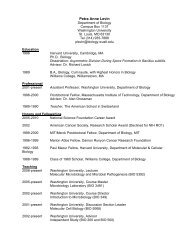Guide for doing FRAP with Leica TCS SP2 - Biocenter
Guide for doing FRAP with Leica TCS SP2 - Biocenter
Guide for doing FRAP with Leica TCS SP2 - Biocenter
Create successful ePaper yourself
Turn your PDF publications into a flip-book with our unique Google optimized e-Paper software.
<strong>FRAP</strong>Figure 1Live cell: Fluorescence recoveryplotted versus time in 8-bit<strong>for</strong>mat (i.e. max = 255). Timeintegrated grey values (intensities)of bleach ROI (green),whole cell ROI (purple), unbleachedpart of cell (orange,more in<strong>for</strong>mation, see text).Three iterations <strong>with</strong> bleachintensity were applied (betweenarrows). The backgroundintensity was not takeninto consideration in this example. Note: Only in the Fly-Mode you are able to monitorthe fluorescence decay duringbleaching.6. Press next. Now the laser intensity <strong>for</strong> bleachinghas to be set. EGFP or FITC have an absorbancemaximum near the 488 nm line of an Ar-Ion laser.Additionally activating the 458 and 476 nm laserlines can increase the bleaching depth. The bleachingdepth is the ratio between the post-bleach intensityF 0 and the prebleach intensity <strong>with</strong>in thebleached region. F 0 should be close or equal tobackground intensity, otherwise the curvature ofthe recovery curve will be small which can bedetrimental to quantitative data analysis (see below).Note: It can be difficult to bleach rapidly diffusingspecies to background intensity. In this case establishingthe <strong>FRAP</strong> procedure using a fixed sample canhelp (Snapp et al. 2003).Note: There are different geometries <strong>for</strong> bleach ROIsavailable in LCS. The most widely used ones are spotphotobleaching (circular ROI) and strip photobleaching(rectangular ROI extending beyond the bordersof the labelled organelle). Strip photobleaching hasbeen described by Snapp et al. (2003), Ellenberg etal. (1997) and Siggia et al. (2000), while spot photobleachingwas used in the landmark paper by Axelrodet al. (1976) and <strong>for</strong> <strong>FRAP</strong> experiments in the nucleus(Phair and Misteli, 2000).8. Run experiment. After the experiment has finished,a window will open plotting the integrated intensity<strong>for</strong> each ROI (Figure 1, Figure 5, raw). The softwareoffers a simple exponential fit to the <strong>FRAP</strong> datagiving an estimate of the time constant, characteristichalf time and rate of the recovery. However thisfit result has to be considered preliminary, becauseat this point no background subtraction, bleachingcorrection and normalization has been carried out.For data processing export the ROI data as a text file.You can then import it into your favourite data processingor statistics software (i.e. Excel, Mathematica,Matlab or others).Note: In order to be able to repeat the experiment<strong>with</strong> exactly the same settings (i.e. <strong>for</strong> repeated photobleachingof the same cells as a test <strong>for</strong> phototoxicityand reproducibility) it is recommended to save thesettings.7. Define a region of interest (ROI) <strong>for</strong> bleaching. It isalways a good idea to save the ROI <strong>for</strong> quantificationlater on (right-click in the image window/ROI/save).Note: The larger the ROI the longer the recovery willtake. Proportionally, the total fluorescence intensityof the whole cell is reduced which aggravates theproblem of photobleaching during post-bleachacquisition. As a rule of thumb use a larger ROI <strong>for</strong>rapidly diffusing proteins and a smaller one <strong>for</strong> moreslowly diffusing proteins.9. Repeat the <strong>FRAP</strong> experiment <strong>with</strong> other cells in thesample (about a dozen cells <strong>for</strong> some basic statistics).<strong>FRAP</strong> experimentsTo provide an example demonstrating the <strong>FRAP</strong> procedurewe will use a 464 kD dextran labelled <strong>with</strong>fluorescein-isothiocyanate (FITC-dextran, FD464), whichis commercially available from most laboratory suppliers.The dextrans can serve as a system to practicethe steps of a real <strong>FRAP</strong> experiment <strong>with</strong>out having touse live cells. A <strong>FRAP</strong> experiment using live cells willalso be given.4Confocal Application Letter











